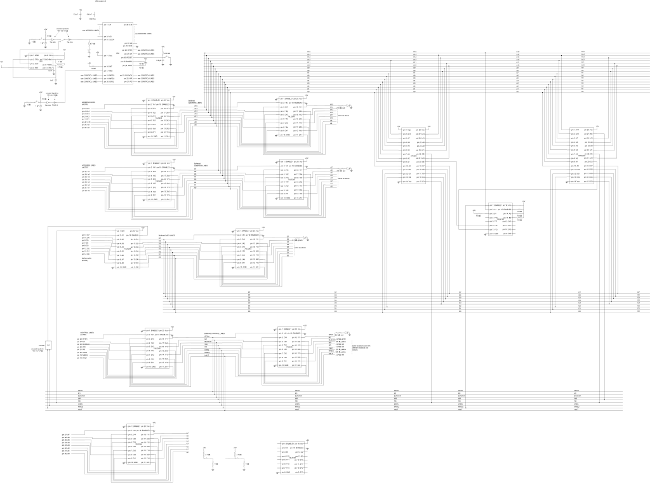Electronic Circuits - interfacing with a Z80 microprocessor v6 (clock and interrupts)
My seb80 custom computer now has its own page here
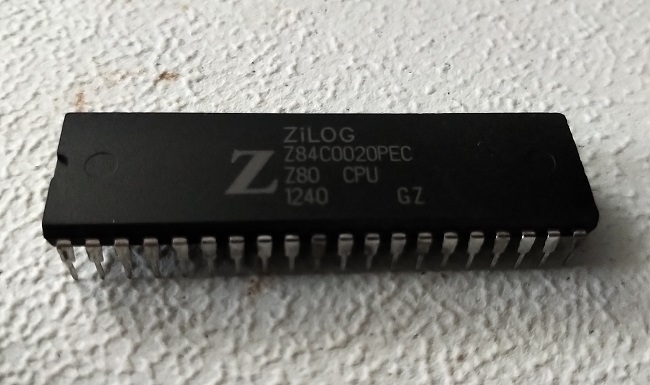
This is version 6 of my Z80 interfacing project. My goal in this version was to introduce an oscillator clock, as well as experiment with the NMI and INT interrupts.
Previous versions:
Previous versions:
Version 6 introduces an oscillator clock and a manual NMI circuit (activated via push button) alongside the manual, push button NMI. To test both NMI and INT interrupts, I wrote three programs.
See the log below for program listings.
TP1 - test program for NMI
TP2 - test program for INT
TP3 - second test program for NMI
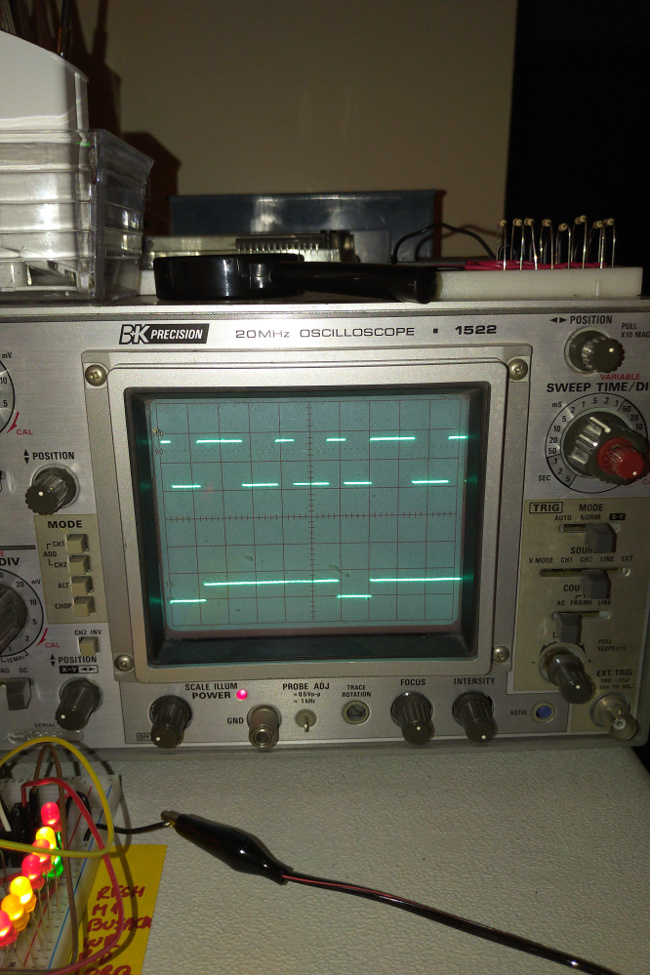
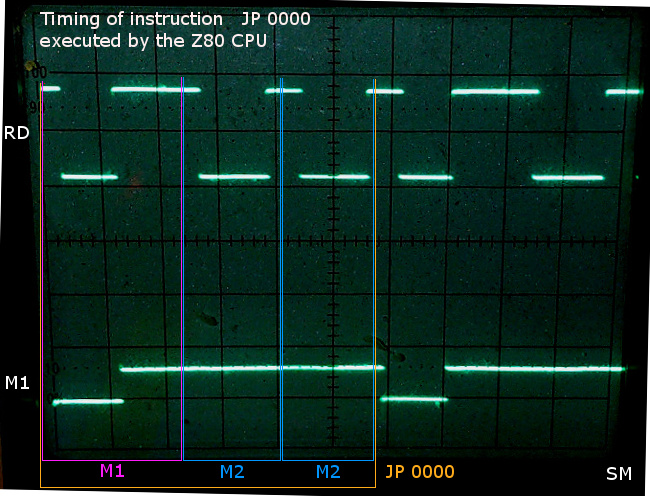

Log
day 1Wired up a 555 circuit.
I did it much faster than the last time I worked with a 555, probably because of the few hundred connections I've made for the Z80.
day 2
Replaced the last two 74F series chips with 74LS, to rely exclusively on the 74LS family of TTL logic ICs.
Broke a pin on one CPU and discovered that another one was faulty (internal short-circuit).
That means I'm down to two good CPUs.
Re-wired the manual clock ICs and introduced a switch which selects between manual clock and 555-driven clock.
This has allowed me for the first time to observe instruction timing on an oscilloscope.
day 3
Reset is now automatic. I used a simple RC circuit to make the RESET pin start low at power-on and reach 2V after a generous 0.8 seconds - giving enough low-level time for three clocks, ensuring a successful reset.
It will also feature a push button to allow manual reset as well, for the cases when clock is manual or just to reset more easily partway through program execution.
day 4
Designed a "generate NMI" button. I debounced it just like the clock button, to prevent multiple NMIs from being generated on a push.
Wrote TP1, the NMI test program.
address bytes mnemonic
0000 ; TP1
0000 ; test program for NMI
0000 ; loops while NMI routine has not run
0000 ; enters infinite loop after NMI routine runs
0000 ;
0000 31 00 90 LD SP,9000h ; stack bottom (NMI needs stack)
0003 3E 00 LD A,0
0005 32 FF FF LD (0FFFFh),A ; hasNmiRun := FALSE
0008 WAIT_NMI: ; do
0008 3A FF FF LD A,(0FFFFh)
000B FE 00 CP 0
000D CA 08 00 JP Z,WAIT_NMI ; while !hasNmiRun
0010 AFTER_NMI:
0010 00 NOP
0011 C3 10 00 JP AFTER_NMI ; infinite loop
0014 FF FF .. DB 82 DUP (0FFh) ; pad up to NMI routine start
0066 NMI_ROUTINE:
0066 3E 01 LD A,1
0068 32 FF FF LD (0FFFFh),A ; hasNmiRun := TRUE
006B ED 45 RETN ; return from NMI
Program was verified successfully! Before NMI is generated, the CPU loops between 0008 and 000D. After NMI is generated, the CPU enters the infinite loop at 0010.
day 5
Changed all pull-up resistors in my design to 10k for consistency's sake.
I'm going to test INT interrupt signals with a bouncy push button. For fun, I will be able to see how many bounces each push generated.
Wrote TP2, the INT test program.
address bytes mnemonic
0000 ; TP2
0000 ; test program for INT
0000 ; infinite loop which reads a variable which holds
0000 ; a count of generated INT signals
0000 ; INT routine increments count variable
0000 ;
0000 31 00 90 LD SP,9000h ; stack bottom (INT needs stack)
0003 21 0F F0 LD HL,0F00Fh
0006 36 00 LD (HL),0 ; initialize counter
0008 ED 56 IM 1 ; choose interrupt mode 1,
000A ; which assumes that the
000A ; interrupt handler is at 0038
000A FB EI ; enable interrupts
000B READ_COUNT:
000B 21 0F F0 LD HL,0F00Fh
000E 7E LD A,(HL) ; read INT count
000F C3 0B 00 JP READ_COUNT ; infinite loop
0012 FF FF ... DB 38 DUP (0FFh) ; pad up to INT handler start
0038 INT_HANDLER:
0038 21 0F F0 LD HL,0F00Fh
003B 34 INC (HL) ; count++
003C ED 4D RETI ; return from INT
Verified that the counter is incremented when an interrupt signal is raised.
Made a second test program for NMI, to count invocations.
address bytes mnemonic
0000 ; TP3
0000 ; a second test program for NMI
0000 ; infinite loop which reads a variable which holds
0000 ; a count of generated NMI signals
0000 ; NMI handler increments count variable
0000 ;
0000 31 00 90 LD SP,9000h ; stack bottom (NMI needs stack)
0003 21 0F F0 LD HL,0F00Fh
0006 36 00 LD (HL),0 ; initialize counter
0008 READ_COUNT:
0008 21 0F F0 LD HL,0F00Fh
000B 7E LD A,(HL) ; read INT count
000C C3 08 00 JP READ_COUNT ; infinite loop
000F FF FF ... DB 89 DUP (0FFh) ; pad up to NMI handler start
0066 NMI_HANDLER:
0066 21 0F F0 LD HL,0F00Fh
0069 34 INC (HL) ; count++
006A ED 45 RETN ; return from NMI
Successfully observed NMI incrementing the counter variable.
Z80 diagrams
Here are some useful diagrams, including the Z80 pinout, timing diagrams, etc.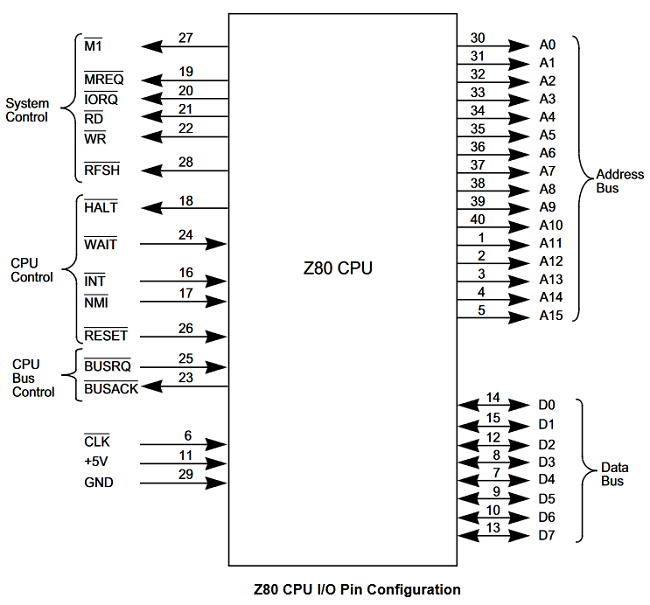

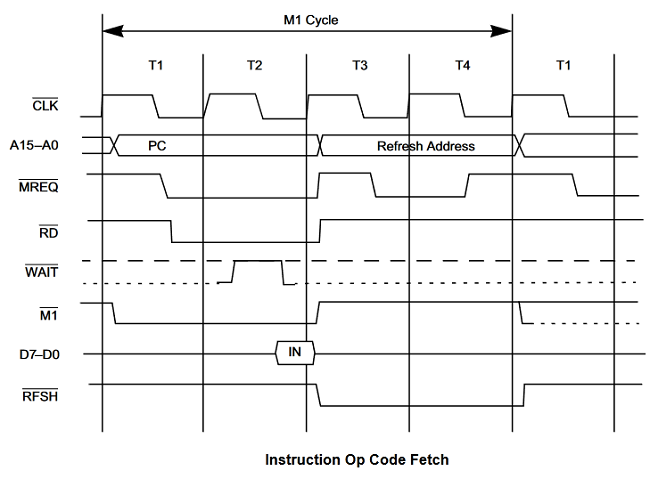


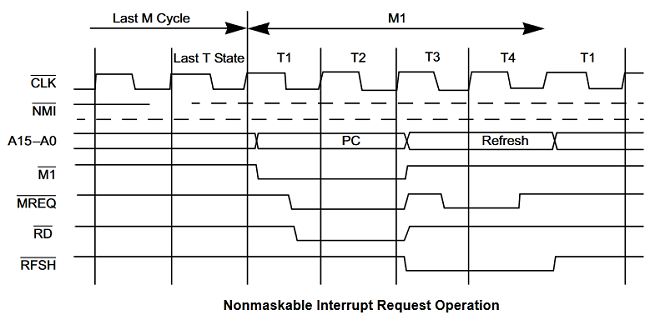



27C256 EPROM diagrams
Here are some useful diagrams, including pinout, timing, etc.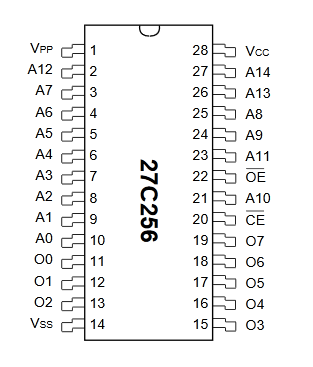
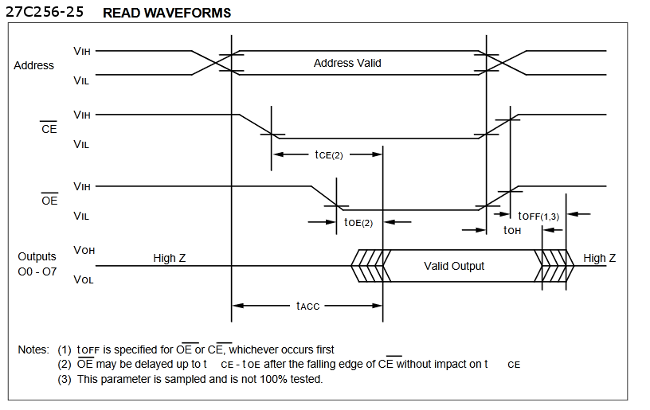
62256 RAM diagrams
Here are some useful diagrams, including pinout, timing, etc.


